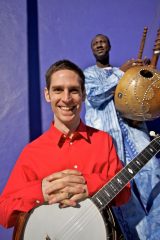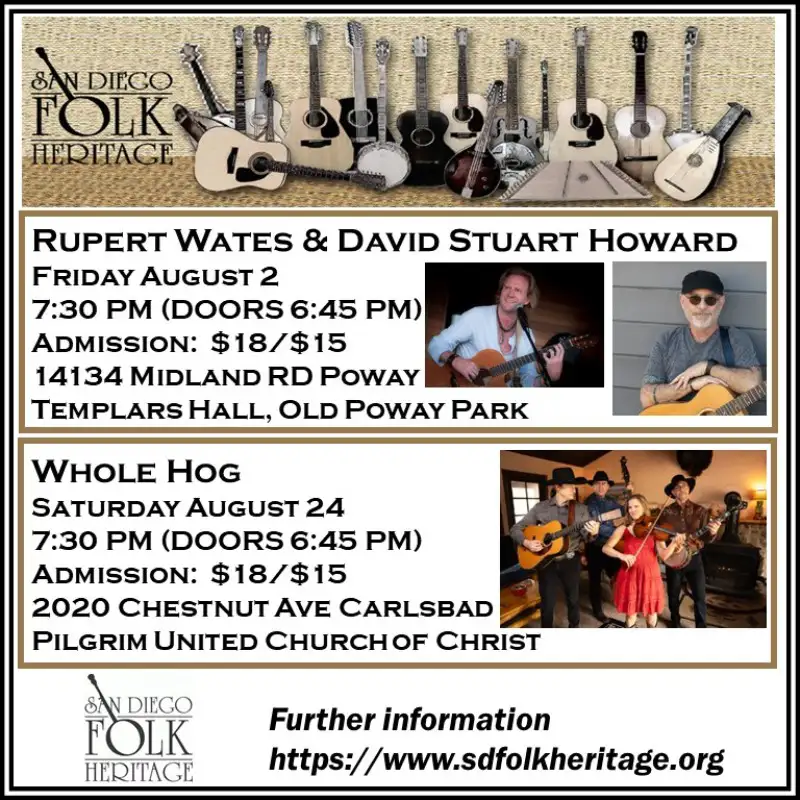Tales From The Road
Jayme Stone: A Global Approach to the Five-String Banjo

Jayme Stone with Yacouba Sissoko. Photo by Amanda Kowalski.
Life is not very exciting if you have only two choices. Just imagine if the world had no Baskin and Robbins, no Haagen Dazs, and the only ice cream you could get was chocolate or vanilla. Or if your cable went on the fritz permanently and the only channels you could get were Fox News and the Weather Channel. Or if Starbucks dropped the Americanos, Macchiatos, and the Tooexpensivatos, and gave you just two choices for your coffee: black or with cream.
Wouldn’t be very exciting, would it?
Traditionally relegated to bluegrass or to old-time country and folk, the five-string banjo has fit into a limited niche like this. Five-string banjo? OK, here’s your choice. You can have some old-time country or old time bluegrass.
That’s it.
Old-time country or bluegrass.
That’s your choice.
That’s the way it’s been for the five-string banjo for a long time. But things have been changing and have gotten a lot more interesting thanks to Jayme Stone.
Stone has made a whole career challenging the stereotypes of the five-string banjo. For him, there are no limits to what this seemingly humble instrument can do. In concert, the Canadian-born musician might play an old-time back porch American folk song, just as Pete Seeger would, strumming his instrument in an old-fashioned clawhammer style. For the next piece he might sit down and perform Bach’s Allemande from the French Suite no. 6 in E Major as a duo with his bassist. There may be modern jazz inspired explorations as well as Eastern European folk music and music from Africa. Or, there might be music hard to classify, being a mixture of two or three of these traditions.
Oh, and there just might be some down home, country bluegrass thrown in for good measure.
With 15 dates in California, including concerts in Santa Barbara, Chico, Encino, and Modesto, Stone kicks off three weeks of touring through the Golden State with a concert at the Loft, the totally hip in a 20th-century retro sort of way music and food venue on the UCSD Campus.
If you’re a traditionalist and are a bit put off with Stone taking a new approach to the banjo, just remember that Earl Scruggs was a groundbreaker for the instrument in his day, too. Stone plays the three-finger Scruggs style, but also incorporates new techniques, at least for the banjo, in his performance. It has been five-string banjo dogma, written in stone and studied as scripture, that a picker will never play two successive notes on the same string. Stone breaks this rule, sometimes playing three or four notes all on the same string, achieving staccato or tremolo effects. He will also slide his left hand up and down a string, making the banjo sound a little like an Indian sitar. Solos that he and his bandmates take are often extended beyond the usual bluegrass one or two go-rounds. For those of you who are diehard bluegrass fans, don’t worry. When Stone and his band play that old-time mountain music, they can sound every bit like back porch Kentuckians.
On the tour Stone will be joined by Sandra Wong, bassist Andrew Small, and drummer Nick Frazier. Wong plays a Swedish fiddle called a nyckelharpa. Predating the modern violin, the instrument looks like a cross between a fiddle and a hurdy-gurdy. Held like a guitar it has a lot of strings, is bowed like a violin, and is noted for its deep resonate sound. Classically trained, Small has performed with Symphony Orchestra Augusta. He is currently finishing his master’s degree at the Yale School of Music. Fellow Canadian Fraser is a drummer and composer known for his creativity and versatility.
Thin, with Mr. Smith Goes to Washington youthful good looks, Stone dresses casually, sometimes in jeans, for his concerts. His interests, like his music, are catholic. On his bookshelf or in his kindle he might be reading Japanese poetry or Brazilian literature. He has been the recipient of a great deal of support for his composition, travel, and study, receiving grants from the Toronto and Canada Councils for the Arts. Most recently he was honored as the Instrumental Artist of the Year by the Canadian Folk Music Awards.
Besides touring and composing, Stone is also a music teacher, taking on beginner through advanced students, and teaching all the styles that he plays, from traditional bluegrass through modern jazz. He taught yoga for years and incorporates aspects of the discipline — posture, ergonomics, and mindfulness — into his music lessons. If you want to take up the five-string banjo or advance your skills to a higher level — but are unable to relocate or commute to meet with Stone in person — he gives lessons, one on one, through Skype.
Dazzled by his introduction to bluegrass music and attending a concert by the man who took the banjo into the realm of jazz and beyond, Bela Fleck, Stone took up the banjo around 1995. Right from the start he dove deep into his instrument and studied with the best. At various times he has been a student of Flying Burrito Brother veteran Alan Munde, as well as Tony Trischka, who had set the banjo on fire in the seventies, and the musician who was his original inspiration, Fleck.
In the early 2000s Stone formed the band Tricycle with guitarist Kevin Manaugh, drummer Kevin Coady, and bassist Paul Mathew. Besides exploring the territories between bluegrass and jazz, the quartet also broke new ground by working with trumpet players and sax players, instruments that have never been traditionally associated with the five-string banjo. The band received a great deal of critical acclaim. In a review, the Toronto news and entertainment magazine Now said that the band should have “hardcore jazz fans reexamining their priorities,” and awarded their CD Emerge and See four stars.
Unlike other American folk instruments, such as the guitar, mandolin, and fiddle, the banjo has it roots in Africa. Because of the banjo, and the bluegrass pickers’ sometimes conscious, sometimes unconscious, choice to incorporate the sound of blues and spirituals into their tunes, the sounds of Africa reverberate through this Appalachian high lonesome music.
Stone has for years studied this African-Appalachian musical relationship. In 2007, during a six-week trip to Mali, sponsored by the Chalmers Arts Fellowship, Stone discovered two instruments, unknown in the West, that are apparent ancestors of the modern banjo. In an interview with the Toronto Star he described the instruments: “The first is the ngoni, one of Mali’s oldest instruments, with three to nine strings depending on the region where it’s made, and a wooden resonator covered by a stretched goatskin. It has no frets and uses gut strings or fishing line, but the sound, the tuning, and even the drone string — the fifth one that ends halfway up the neck — are exactly the same as the contemporary banjo.”
He noted as well the clawhammer style — one you can see being used by Pete Seeger in YouTube videos — being used on a two-stringed instrument resembling a lute and called the konou, which is played almost exclusively in the desolate Dogon region of Mali. He said of this discovery, “I spent enough time there to learn there’s a whole musical tradition built around the instrument. Its melody lines carry cues to ancestral stories that are played out in long, wild musical sessions that can last all night.”
In 2008 he released an entire CD that explores the Africa-Appalachia musical relationship. Titled Africa to Appalachia, Stone collaborated with Mansa Sissoko, a young singer/songwriter who is originally from Mali. Sissoko is a master of the kora, a traditional sweet sounding 21-stringed African harp, which he performs on the recording. Seven of the numbers on the disk are Sissoko’s original compositions. Other material on the disk comes from traditional American folk and bluegrass. Stone incorporated African rhythms on two of these — “June Apple” and “Chinquapin Hunting” — which further accentuate the African roots that these tunes share.
If Stone’s most recent recording, Room of Wonders, is any indication, Stone’s concert at the Loft promises to be a sonic world tour. The music and inspiration of the disk comes from Brazil, the Appalachians, Italy, Nordic Europe, and even the odd-metered music of Bulgaria.
Stone explains that the common thread found throughout this music from all over the world is dance. “I was listening to Bach’s French Suites while cooking. The performance had such a lilt to it that I literally wanted to dance,” he says. “It was an epiphany moment. Bach used European folk dance forms to inform his own music. I realized I could explore folk dances in my own way, but with a worldwide scope.”
Stone keeps that worldwide vision as a source of inspiration. He wants more than two choices, more than old-time and bluegrass and lets the whole globe open up new musical possibilities. “The world itself is like one vast room full of all these wonders,” he says. “That’s perhaps a hallmark of this day and age. The whole world feels open and accessible. And as a musician, you walk into a room — a concert hall or a living room, anywhere in the world — and by having instruments there, you can evoke other places, other centuries, and other wonders.”
See Jayme Stone in concert on Wednesday, The Loft, UCSD Campus, 8pm. For further information and to buy tickets: http://www.artpwr.com/events/909






